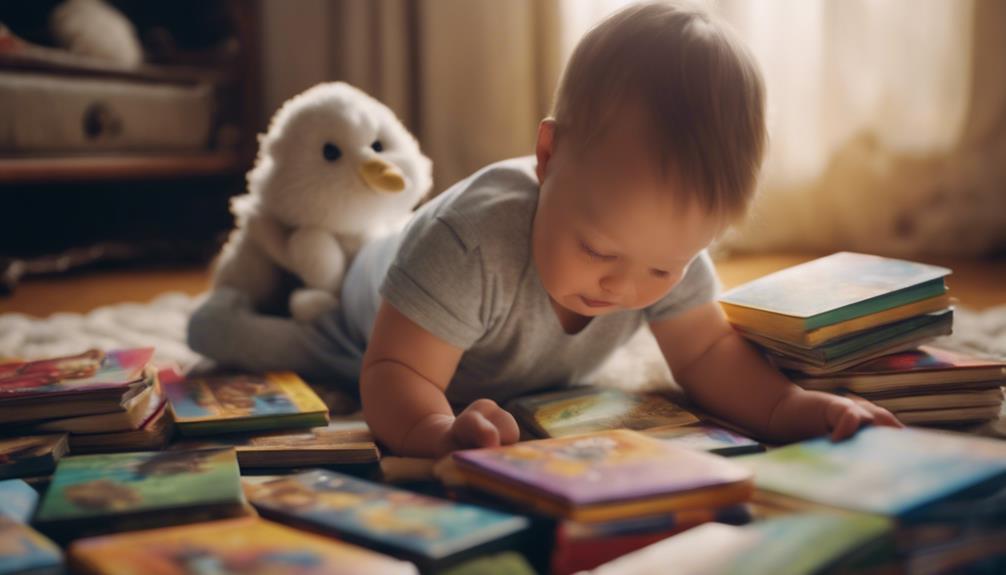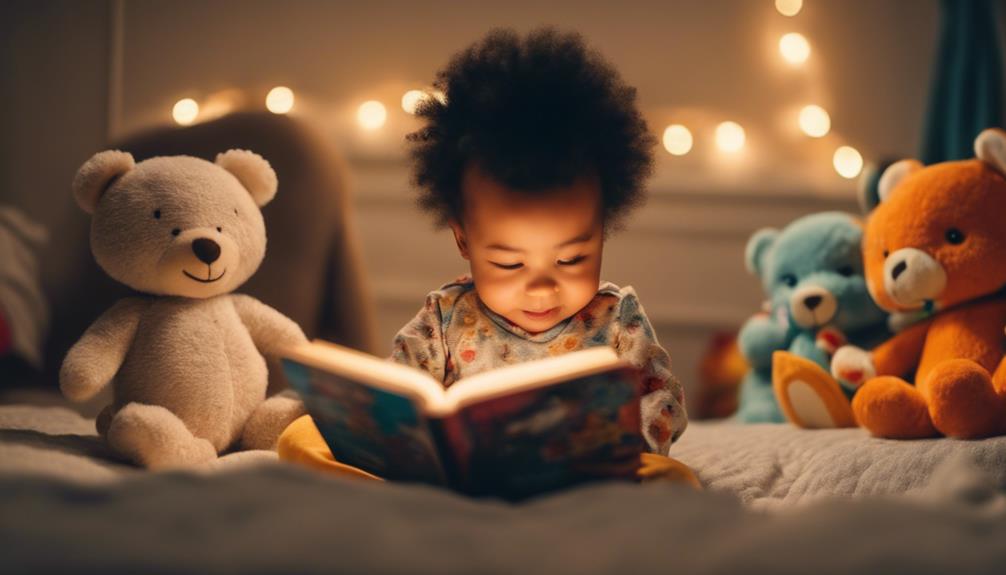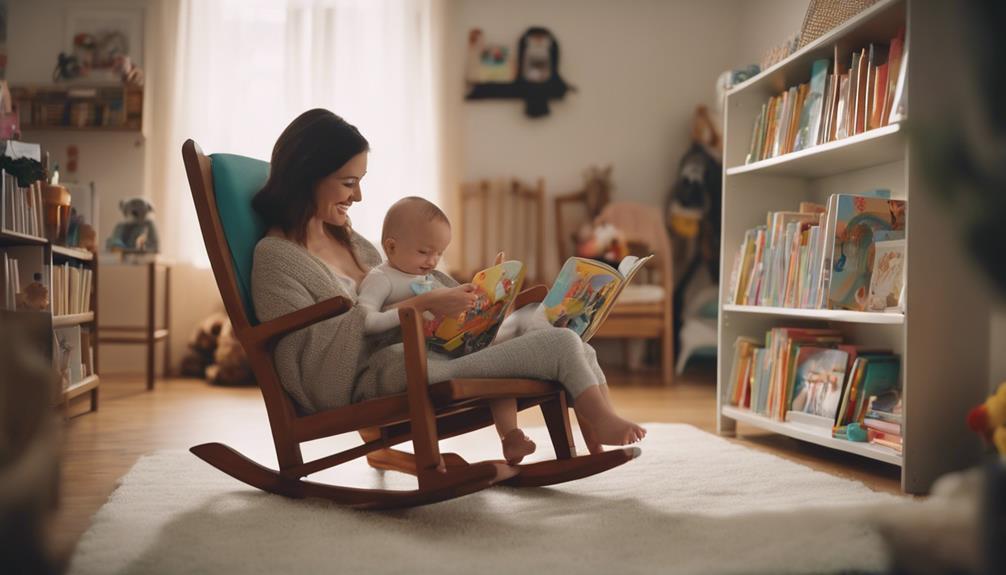Creating a consistent nightly ritual of bedtime stories for your little one offers numerous advantages. Reading before bed not only improves language skills and cognitive development, but also strengthens emotional bonds and fosters a love for learning. To ensure a cozy atmosphere, focus on incorporating simple rhythms, soothing illustrations, and interactive books with tactile elements. To make reading enjoyable, utilize engaging illustrations, lively voices, and interactive gestures. Encourage reluctant readers by selecting interactive books and involving them in choosing stories. Enhancing the storytelling experience with interactive activities, role-playing, and themed crafts enhances memory retention and promotes active participation. Craft projects deepen comprehension and provide a fun educational experience for kids.
Key Takeaways
- Prioritize calming stories with simple rhythms and engaging illustrations.
- Establish a cozy reading environment with snuggles and interactive elements.
- Choose books that incorporate bedtime routines or familiar objects.
- Encourage touching textures and using funny voices for an engaging experience.
- Extend the storytime with interactive activities like acting out parts or themed crafts.
Benefits of Bedtime Reading
Discover the numerous benefits of bedtime reading for your baby. Establishing a bedtime routine that includes reading can have a significant impact on your child's development.
Through bedtime stories, you aren't only enhancing your baby's language skills but also fostering an emotional connection that's vital for their overall well-being. According to child development experts, shared reading at bedtime strengthens the bond between parent and baby, creating a sense of security and comfort.
This nightly routine can also contribute to your baby's cognitive development by stimulating their imagination and encouraging creative thinking.
Moreover, bedtime stories play a significant role in instilling a love for learning from a young age, setting a positive attitude towards education that can last a lifetime.
By incorporating reading into your bedtime routine, you aren't only promoting literacy but also aiding in the development of better sleep habits for your baby.
Ultimately, bedtime reading isn't just a time for stories; it's a valuable opportunity to nurture your baby's growth and well-being.
Choosing the Right Story

When selecting bedtime stories for your baby, prioritize books with simple rhythms and calming illustrations. Opt for board books with sturdy pages that can withstand handling by little hands.
Look for stories that incorporate bedtime routines or familiar objects to create a sense of comfort. Choose books with high contrast images and bold colors to capture your baby's attention.
Consider interactive books with textures, flaps, or mirrors to engage your baby's senses during storytime. These elements contribute to a soothing and comforting bedtime routine for your little one.
Creating a Cozy Environment

Snuggling up close together in a comfortable spot creates a cozy reading environment for bedtime stories. To enhance engagement and enjoyment during bedtime routines, consider the following:
- Allow your child to hold the book or turn the pages: 'Letting the child interact with the book can increase their interest and connection to the story,' advises child psychologist Dr. Smith.
- Use bedtime stories as an opportunity for your child to express their thoughts and feelings: 'Encouraging children to talk about the story can help develop their communication skills and emotional intelligence,' suggests parenting expert Dr. Johnson.
- Quality one-on-one time during reading strengthens bonds between parent and child: 'Spending this time together not only benefits the child's development but also fosters a sense of security and closeness,' notes child development specialist Dr. Williams.
Creating a soothing environment fosters a positive tone for sleep, making bedtime stories a cherished part of your nightly routine.
Making Reading Fun

To enhance your baby's reading experience, select books with engaging illustrations and interactive elements. These elements not only capture your little one's attention but also make the bedtime reading routine an enjoyable experience.
Incorporating funny voices, sound effects, and gestures can further enhance the interactive nature of the story, making it a memorable part of your bedtime routine. Opt for board books with sturdy pages that can withstand your baby's exploration and handling, ensuring that they can fully engage with the book's content.
Encourage your baby to touch and feel different textures within the book for a sensory experience that adds depth to the storytelling. Additionally, choosing books with simple, repetitive language patterns can help your baby anticipate and join in during storytime, creating a fun and engaging atmosphere that will make bedtime reading a cherished part of your daily routine.
Tips for Engaging Reluctant Readers

When involving reluctant readers during bedtime, it's crucial to choose books with engaging illustrations and interactive features.
Involving your child in selecting stories can increase their interest and create a sense of ownership in the reading routine.
Additionally, incorporating themed stories based on your child's preferences can make the reading experience more enjoyable and engaging.
Interactive Reading Activities
Engage reluctant readers more effectively by incorporating interactive elements such as pop-up books, touch-and-feel textures, or lift-the-flap features. These tools can transform reading into a captivating experience for kids, making it more engaging and enjoyable.
To enhance participation and captivate young minds, consider the following:
- Props: Utilize props related to the story to add a visual element and immerse children in the narrative.
- Puppets: Bring characters to life with puppets, allowing kids to interact with the story in a dynamic way.
- Technology: Integrate technology by using interactive e-books or apps that incorporate sound effects, animations, and other interactive features to make the reading experience more stimulating.
Encouraging Reading Participation
Encourage reluctant readers by allowing them to have a choice in selecting the bedtime story. Giving them the autonomy to pick a story that interests them can increase their engagement and make the bedtime routine more enjoyable.
Utilize interactive books or those with sensory elements to captivate reluctant readers. These types of stories can help maintain their focus and make the reading experience more interactive.
Introduce props or puppets to bring the bedtime book to life, enhancing the storytelling and making it more immersive for reluctant readers.
Create a cozy environment for reading by dimming the lights, using soft blankets, and ensuring a comfortable seating arrangement. Establishing a regular bedtime reading habit in a warm and inviting setting can make reluctant readers more enthusiastic to participate.
Consider offering incentives or rewards for their involvement in bedtime stories to motivate them further and make the reading experience enjoyable for everyone involved.
Extending the Storytime Experience

To extend the storytime experience, consider incorporating interactive storytelling activities like finger puppets or shadow play to make the narrative come alive for your baby.
Bedtime story-themed crafts such as creating a simple dream catcher or painting a starry night scene can further enhance the storytelling experience and stimulate your baby's creativity.
These engaging activities not only add depth to the storytime routine but also provide valuable opportunities for bonding and learning.
Interactive Storytelling Activities
For an enriched bedtime storytelling experience, consider incorporating interactive activities that stimulate your child's imagination and engagement with the narrative. Here are some ideas to enhance your bedtime routine:
Ask open-ended questions about the story to engage your child's critical thinking skills and encourage deeper engagement with the bedtime story.
Encourage your child to act out parts of the story using props or costumes to make the storytelling experience more interactive and immersive.
Use puppets or stuffed animals to retell the story or create new adventures, fostering creativity and enhancing storytelling skills.
Incorporating sensory elements like scented playdough, textured fabrics, or sound effects can further enrich the interactive storytelling experience, making the bedtime story more memorable and impactful for your child.
Bedtime Story Themed Crafts
Enhance your child's bedtime storytelling experience by incorporating themed crafts that extend the storytime adventure and foster creative engagement. Themed crafts based on the bedtime story can provide a hands-on learning experience for children, reinforcing the story's message and enhancing comprehension. By creating crafts related to the bedtime story, children can actively engage with the characters and themes, making the story more interactive and memorable.
Crafts offer an interactive way for children to connect with the bedtime story, encouraging creativity and imagination. According to child development experts, engaging in crafts after reading a bedtime story can help children internalize the story's lessons and themes. Dr. Smith, a child psychologist, states, 'Themed crafts provide a fun and effective way for children to deepen their understanding of the bedtime story.'
Frequently Asked Questions
How to Create a Bedtime Routine for Baby?
To create a bedtime routine for your baby, start by establishing consistent calming activities like a warm bath and lullabies. Choose age-appropriate bedtime stories with engaging illustrations. Create a cozy environment with soft blankets and dim lighting.
What Age Should You Start a Night Time Routine for a Baby?
Start a bedtime routine for your baby around 2-3 months. Establishing early habits helps create a cozy bedtime environment. Consistency is key; a warm bath, gentle massage, lullabies, and a bedtime story can guide your little one into peaceful sleep.
What Is a Good Night Time Routine for Babies?
For babies, a good nighttime routine involves activities like a warm bath, cozy pajamas, a soothing bedtime story, and cuddles before sleep. Consistency in the routine helps develop healthy sleep habits and signals bedtime.
What Age Should a Baby Have a Bedtime Routine?
You should start a bedtime routine for your baby as early as 2-3 months old. Establishing consistency early helps develop healthy sleep habits. It signals to your baby that it's time to wind down, promoting relaxation and comfort before sleep.
Conclusion
To sum up, bedtime stories for babies aren't only a delightful way to bond with your little one, but they also provide numerous developmental benefits.
As psychologist Dr. Maryanne Wolf states, 'Reading to young children stimulates brain development and strengthens parent-child relationships.'
By incorporating a nightly routine of reading, you're setting the stage for a lifetime love of reading and fostering important cognitive and emotional skills in your child.
So, grab a book and start creating those cherished bedtime memories tonight.










